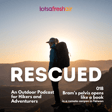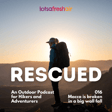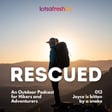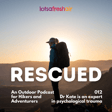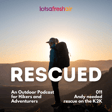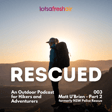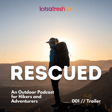Introduction and Overview
00:00:00
Speaker
Rescued is a podcast of conversations with rescuers and those who've been rescued. It's about the lessons we learn about ourselves, the places we go and why, without judgement, to help us have better adventures, manage risk and deal with the unexpected.
00:00:18
Speaker
We venture into wild places to get away from it all. But when it comes to calling for help, letting someone know we're delayed, or even just giving our loved ones peace of mind, we have to rely on satellite communication methods because mobile phone coverage often doesn't reach to where we want to
Interview with Linda Berryman on PLBs and Satellite Technology
00:00:35
Speaker
In this episode, I speak with Linda Berryman from AMSA. That's the Australian Maritime Safety Authority in Canberra. We do a deep dive into personal locator beacons, those PLBs, along with two-way communication devices such as Zolio, InReach or Spot Trackers. And, yep, we also talk about the satellite capability with the iPhone 14 and some other very exciting technology that's just around the corner.
00:01:03
Speaker
Linda, why don't we kick it off by just letting people know a little bit about your world and how you ended up working at AMSA and what your job is there? I've been very fortunate to work at AMSA for about 18 years. Prior to that, I worked in the private industry working for one of the manufacturers for distress alerting devices. Essentially, I've specialized in distress alerting technologies and systems for about 20 plus years.
00:01:26
Speaker
Wow. So both sides then of the coin. Yeah. So it's such a great opportunity where I can learn about the products technically, but also bring that into that policy, government and standard development and influence how Search and Rescue is performed. You talked about AMSA then. For those of us who don't know, just tell
Role of AMSA in Maritime Safety and Rescue
00:01:47
Speaker
us more. What does AMSA stand for and what does it do and how does it sit within government?
00:01:52
Speaker
So the Australian Maritime Safety Authority, so they have more than one function. And so they are the national system regulator for domestic commercial vessels. They also look after search and rescue in Australia, and they also are responsible in relation to environmental pollution.
00:02:11
Speaker
So, it's got several roles and responsibilities. So, as a bushwalker or a hiker and outdoor adventurer, how would we interact with AMSA? What kind of role can you guys play within our experience of how we venture into wild places?
00:02:27
Speaker
So essentially, if you were to purchase a 406 megahertz distress beacon, so whether that's a PLB, EPIRB or ELT, they need to be registered and you can register those with AMPSA and that's a free registration service. We also provide customer service if you have any difficulties with that process or would like to navigate the space of distress alerting beacons or devices and how that system works. You can certainly contact us for further assistance.
00:02:57
Speaker
So in relation to how bushwalkers may engage with AMSA, I think it might primarily be around the PLB and registering it with AMSA. You mentioned three different acronyms there. So the PLB.
00:03:09
Speaker
the EPIRB and the ELT. Can you just give me a quick overview of what's the difference between those three?
Differences Between PLB, EPIRB, and ELT
00:03:16
Speaker
Sure. A PLB, personal locator beacon, that's a small, compact, lightweight, multi-environment friendly device. Whereas an EPIRB is an emergency position indicating radio beacon. They're a bigger, bulkier device designed for maritime use primarily, and they're designed to float in the water, essentially.
00:03:36
Speaker
and more commonly they're associated with a vessel and an ELT is an emergency locating transmitter and they're designed and fitted in an aircraft so they can be say crash impact activated. So a PLB is multi-environment in that it can be used for land maritime or aviation they're small and you can carry them with you.
00:03:56
Speaker
Yeah, and given how much when we carry everything on our back, we want to keep everything as lightweight and as compact as possible, it sounds like a PLB is definitely the way we want to be heading when we think about taking a beacon with us. Now, you mentioned something else there. You said a 406.
00:04:15
Speaker
beacon as well. So what's that 406 megahertz? What does that refer
Understanding 406 MHz Frequency and Cospas-Sarsat System
00:04:19
Speaker
to? Good question. So a 406 megahertz is the distress frequency that is used in a PLB and that is detected by the International Cospass satellite system, which is dedicated to search and rescue.
00:04:33
Speaker
Ah, nice. OK, so there's satellites up there above us zooming around that don't have to worry about things like telecommunications or any other comms. They just focus on rescue around the world. Is that correct? The Cospass Sarsat satellites, they're not dedicated just to Cospass Sarsat. What they are generally is like a payload, which is, say, the size of a shoe box, which is installed on board a, say, a weather satellite.
00:05:02
Speaker
And so it's orbiting, but it has the capability of detecting the 406 megahertz. OK, so who owns those satellites? They're government owned. So it's a combination of USA, Canada, France and Russia.
00:05:18
Speaker
But if I say I buy a PLB here in Australia and I take it with me anywhere in the world, am I still going to be able to use it anywhere in the world? Yes. So 406 megahertz is an international distress frequency. So as detected, there's global coverage for that signal.
00:05:35
Speaker
Okay, fantastic. Good to know. We've got a PLB. I know the 406 is the rescue frequency internationally. I can use it anywhere in the world. Now, you also mentioned that something AMSA does is have a registration system.
Importance of Registering PLBs
00:05:51
Speaker
Talk to me a bit about that.
00:05:53
Speaker
Yes, so it's really important that when you purchase a distress beacon that you register it with AMSA and that includes details such as your name, address, phone number, your emergency contact details. You can provide up to between one and three name and phone numbers. You can also provide, so let's say it's for land use, you can provide your vehicle details. You could also include and recommend things like trip details so you can include
00:06:22
Speaker
the route you're traveling, how many people in the group, the dates, you know, ETA, what sort of supplies you've got, many medical conditions. So in the event that that beacon is detected, that information is presented in real time to the search and rescue officer. And that potentially could be critical information that could certainly assist in a more efficient and effective coordination and response.
00:06:49
Speaker
Okay wow okay so i've got my beacon i've gone to answer i've registered all the details and that trip intentions form sounds great so that's something i can login to sort of regularly every time i do a trip is that sort of how that works.
00:07:04
Speaker
Yeah, it's all online. So you have full control of your registration details and your trip details if you would like to lodge them. You can even upload images or photos. Some people take a photo of themselves or their family, even their vehicle, their vessel, if it's linked to a vessel or an aircraft. So it's a free text comment box so you can enter it as much information as you would like.
00:07:30
Speaker
And what about uploading, say, a map, say a map with a route plan on it? Could I do that
How to Activate and Use a PLB
00:07:35
Speaker
as well? Yeah, the more information you can provide, I think would be great. If you weren't to upload and provide that information, then it's really important that people consider in notifying their nominated emergency contacts that information.
00:07:49
Speaker
When you say when a beacon is detected, let's say I am out on a trip and I need to turn the beacon on. Is it a confusing thing to use, this PLB? What do I see? How does someone use that? I think it's really important before you even embark on an adventure, always familiarise yourself with your safety equipment.
00:08:09
Speaker
And so there is a user manual available with the product, and there's also guidance available written on the product as well. And some products have a little bit of nuances, but essentially with a PLB, you need to, when you need to activate it, you need to erect the antenna or deploy the antenna into a vertical position, and then you'll be
00:08:29
Speaker
able to see an on or activation button and you need to press that. So all distress beacons have a two-step activation process and that's really essentially to minimize any inadvertent alerts.
00:08:42
Speaker
You'd feel pretty bad if you thought, oh, no, I don't want to accidentally set it off or it's down the bottom of my pack or I've dropped it and it's bounced down the stairs or something. Yeah. And look, that can happen. And don't worry, accidental activations do happen. But if it does, don't panic. Just switch it off immediately and call AMPSA on 1800 641 792. And there's no penalty for accidental activation.
00:09:07
Speaker
Oh, that's good to know. That's good to know. So I'll put that number and links to AMSA in the show notes as well. So there'll be lots of places people can go for more info. But when you do activate the PLB, maybe just to elaborate a little bit further what to expect, that is also beneficial to understand.
New PLB Models with Return Link Service
00:09:25
Speaker
And so you'll see the strobe light will start flashing and you'll hear an audible beep sound. And so that gives you the reassurance that the beacon is functioning and it's transmitting.
00:09:37
Speaker
There's also some models, if you were to buy one with a return link service, that means you'll get an acknowledgement message that the distress alert message has been received. And that'll be displayed as a different color light on the PLB. Okay. So there's some models on the market that display a blue LED light.
00:09:54
Speaker
Yeah, is it a relatively new functionality? Yeah, it's been available in Australia since October 2022. Okay, that's great. Because I guess that's something, because a PLB is, it's just a one-way device in many regards, isn't it? You can't actually, unless you have, like you say, one of these newer ones that can give us that message or the different color light that's been received.
00:10:20
Speaker
I've heard people say, look, I pushed the button, but I just didn't know if help was on the way. Exactly. Historically, 406 megahertz distress beacons have been a one-way transmission device, but we've seen that advancement in technology now where we're now seeing them equipped with return link service as an option. When you go to buy your PLB,
00:10:43
Speaker
have a look at the different models available on the market. And if it's got RLS, then you may like to consider that and it will give you that reassurance of capability of confirming the message has been received. Also, just to maybe extend that a little bit further, so that return link service message confirmation, that will give you the reassurance that the message has been received
00:11:08
Speaker
But it does not mean that help is on the way. So it's still important that you maintain your survivability until help is on the way. Yeah, absolutely. Because I mean, gosh, if you sort of knew or you saw that, hey, oh, look, help's coming. You might go, oh, I've only got one Mars bar left. I'm going to. Yes.
00:11:24
Speaker
Yeah, don't drink all your water and eat all your food supplies. You still need to stretch it out. Yeah, because there's a lot of things that can affect the timeliness of help reaching you, whether it be availability of resources or weather conditions, those kind of things. And I guess it always comes back to being
00:11:46
Speaker
well-prepared that any time you go out, you've got things with you that you can, if circumstances change, you can look after yourself. A little bit of that emergency food and some shelter, some warm clothes, those kinds of things. Yeah, that's right. We've let a beacon off a PLB. Let's say we do have that RLS return link service technology in one of the newer ones there. I can see that the message has been received.
00:12:14
Speaker
What can we expect then? What actually happens that we don't see at your end of things?
Handling PLB Distress Signals
00:12:20
Speaker
What happens in Canberra and what happens up in the satellites? In the event that you've activated the beacon and it's being deployed and positioned correctly, then what will happen is that the 406 MHz is detected by the International COSPAS satellite system.
00:12:37
Speaker
That information is relayed to a ground station, which is known as a local user terminal. And that is then forwarded to the Mission Control Centre, which is also based in Canberra.
00:12:50
Speaker
And they then relay the distress message to the Rescue Coordination Center. And then the RCC will then identify the appropriate asset or resource to be tasked. And that's actually an automated process. So it happens very quickly. So that 406 megahertz distress beacon, when you activate it, the first burst or transmission is sent 50 seconds after you activate the beacon. Right.
00:13:17
Speaker
So we're normally detecting that beacon within a couple of minutes. It's very quick. Wow. And you've mentioned they're about positioning correctly. And I think that's something that we need to be aware of too. So the places that we go, the environments we find ourselves in, they're in canyons or gullies and that kind of thing. What should we do and think about before we actually push that button?
00:13:43
Speaker
So briefly before I mentioned that the aerial must be vertical. So in other words, it needs to be pointing towards the sky, preferably 180 degrees visibility and away from trees, buildings, mountains, vehicles. Basically, you want to ensure that the beacon is positioned in a clear and open area. And if possible, positioning it at the highest point. So if you're in a deep ravine or gully, you may have to consider repositioning yourself if that's possible.
00:14:12
Speaker
And it's all got to do with line of sight or elevation angle of the satellite. And so sometimes the mountain may block visibility for a particular satellite. And this is regardless of whatever device you're using, you need to have visibility of that satellite system. And so mountains can block that.
00:14:34
Speaker
that's something to be mindful of. But with the COSPAS satellite system, it actually comprises of three different constellations and they're positioned at different elevation angles. And so there's the LEO system, MEO and GEO.
00:14:50
Speaker
some of them are pole orbiting and some of them are geostationary. So with those LEO, MEO and GEO, the first layer, that's the LEO, isn't it? The first layer, the low earth orbit? Yeah. And so what's then the MEO and the GEO? So they're a higher altitude or elevation. Okay.
Satellite Constellations and PLB Signal Detection
00:15:12
Speaker
Compared to the LEO.
00:15:12
Speaker
A lot higher. A lot higher, okay. You mentioned it's about this line of sight and the maximum sky above us, because I guess if the Leo and the Mio are spinning around, circling around the Earth, if there's only a small slit of sky above us, say we're in a canyon, then the period of time that that satellite's above us is going to be pretty short, isn't it?
00:15:39
Speaker
Yeah, so the way, the best way to explain it is that the GEOs, so we have coverage over Australia with the GEO constellation, because that's say fixed relative to the Earth. Okay. We have coverage of Australia with the MEO. So you only need three MEO satellites to have worldwide coverage. And we already have that established.
00:16:05
Speaker
The LEO satellites, because they're polar orbiting, they average in orbit, say, every average of 90 minutes, but can be up to five hours. And so their footprint keeps moving. Got it. What you'll find is you're going to have a very strong possibility of being detected by the GEO, the MEO, as long as there's just no obstruction.
00:16:27
Speaker
you essentially need to ensure that the PLB is positioned in the correct position to enable detection by the satellite system. Great. Okay. So I'm going to come back in a little bit to why that LEO, MEO and GEO might come into play with some of the other devices we might talk about later as well. So we've now got our beacon, we've set it off, we've got it in the best position we can. And obviously that's going to depend on their circumstances too. And
00:16:57
Speaker
Certainly, the last thing you want to do if you've got an injury is to injure yourself more or potentially open yourself up to slipping or falling by trying to get to a higher.
00:17:12
Speaker
higher place because anecdotally, I've heard from people within police rescue that they're amazed at how effective PLBs are, even within narrow gullies and within narrow slots and places like that. I guess that's something to always keep in mind is to just make wise, well thought out and measured decisions. That's right.
00:17:37
Speaker
So going back to what happens when you push the button, you said it goes up to the satellites and down to the LUT.
Rescue Coordination Center Operations
00:17:43
Speaker
Local user terminal. And then bounces to another one and then ends up in that rescue center. What was the name of the center? Rescue Coordination Center. Okay. So the Rescue Coordination Center. Now that's in Canberra and that's, is that staffed
00:17:57
Speaker
Like 24 seven or how does what does that look like inside? So the AMSA Response Center has got staff members that specialize in maritime aviation and land. So they've got that operational expertise from industry and they bring that into the Rescue Coordination Center so that they're suitably skilled and have the knowledge to help with the coordination response.
00:18:21
Speaker
Right. I'm fascinated. I'm kind of imagining those movies where it's sort of like Houston with the big screens all up on the wall and dark in the room and everyone's got this blue glow on their faces from the screens. There are a lot of screens, I must say.
00:18:39
Speaker
So, a call comes in and it's landed there at the RCC. What happens then? So, essentially, when the distress beacon is detected, the registration details are presented straight away. It's all automated.
00:18:55
Speaker
And those details are presented so they can see the name of the owner of the beacon, contact details, emergency contacts and any potential trip details that have been lodged. And then the idea is that if required and they require further intelligence, they may need to contact the nominated emergency contact to a
00:19:16
Speaker
verify the nature of distress or concern for welfare for that individual or persons or group, and then gather some additional intelligence or information. And if that location of distress is identified or confirmed on land, the search and rescue coordination response is transferred to the state police. And if the state police require further assistance from AMSA, then they can seek that as well.
00:19:40
Speaker
I guess there's something that I forgot to ask you about then, too, is what if, you know, let's say my beacon goes off, my name comes up in the screen like, oh, not Carol again, you know, would they try and ring me direct? Because what if it's like to verify it's not an accidental activation? That's right. So the search and rescue officer can attempt to call the registered owner and all the emergency contacts in that process.
00:20:06
Speaker
Massive thanks for the support from the team at Patti Pallon, who since 1930 have been leaders in travel and outdoor adventure. In fact, did you know that Patti himself, a member of the Sydney Bushwalkers Club, was a volunteer in the original Search and Rescue Arm of the Federation of Bushwalking Clubs in New South Wales? Hmm, nice one Patti.
00:20:27
Speaker
Now something I'd heard about the 406 megahertz beacons is that they're also picked up by planes and other aircraft.
Aircraft Detection of PLB Signals
00:20:34
Speaker
How does that all work and what happens if they do pick one up? Yeah, so the 406 megahertz distress beacons also transmit on 1 to 1.5 megahertz. That is the international aviation distress frequency and it's also utilized for homing purposes.
00:20:51
Speaker
So to explain that in a little bit more detail, if AMPSA or an asset or resource is tasked to respond, they can utilize direction homing equipment. And once they're tasked to a set location, once they get close or closer to the area, they can utilize the direction finding equipment to home in on the one to 1.5 megabits.
00:21:14
Speaker
But some direction finding equipment also has the 406 homing capability as well. But the idea is that once they're in the vicinity, they have a homing frequency of which enables them to try and find the person or persons in distress. And that's when you want to utilize your visual aids. That's the benefit. Once you're hearing or seeing someone looking,
00:21:36
Speaker
or a plane flying overhead, use some visual aids to pinpoint your location and help them because they're homing in on a frequency, but certainly the visual aids can help there as well. And then in the event that any aircraft overflying are detecting 1 to 1.5 megahertz, they report that to air traffic control, who then subsequently report that to the Rescue Coordination Center. And that's another piece of intelligence that comes into the Rescue Center, which can help them collaborate
00:22:06
Speaker
that beacon that's transmitting. Yeah, that's really really good to know. So with that homing capability, do you know how accurate that is? Like is it sort of, you know, does it give the location to within, you know, a kilometer or a couple of hundred meters or what's sort of the area that they're going to start looking for us in?
00:22:24
Speaker
So the 406 megahertz, that is just a standard frequency. So that's a five kilometer circular radius accuracy. And the GNSS equipped or GPS equipped is more commonly referred to or known as, that's 120 meters accuracy. But what we're seeing is
00:22:45
Speaker
PLBs, you can only buy a PLB with GPS in them these days. So you automatically can safely say that yes, 120 meters accuracy. What's also beneficial to understand is that the MIO constellation, the COSPAS-SARSAT,
00:23:02
Speaker
has the capability of triangulating and calculating your location in conjunction with that GNSS data that's coming in. So we have a secondary source and ability of being able to calculate your location as well, which is just as or once it's at full constellation will be more accurate than the GNSS.
00:23:24
Speaker
That's amazing. That'll be a big help for emergency services for sure. I want to pick up on something you
Using Visual Aids in Rescues
00:23:30
Speaker
mentioned there. When you hear that there's potentially aircraft in the air or you might even hear people calling out or whistling or something like that if there's a ground party coming to you, what are some of the things that we could do in terms of that visual, making ourselves visually aware so it's easy to find?
00:23:49
Speaker
Oh, sure. So a couple of ideas. A, the beacon will have a strobe light or a LED that's flashing. So there's a light source. You may have a strobe light. You may like to consider lighting a fire or get some smoke going. As long as it's not a fire hazard, of course, you don't want to create another problem for yourself.
00:24:08
Speaker
Otherwise, a contrasting color would also be beneficial to outlay. Or some people even consider, say, a V sheet that is commonly known in the marine industry. So a big orange sheet of plastic which has black letter V on it. So that can also enable that pinpointing.
00:24:27
Speaker
So bright colors, even if you're not using it with a patient, those silver emergency blankets are great. Yeah. Colored clothing, torches, head torches, camera flashes, if anyone still carries camera flashes, anything that's going to help that aircraft or people find and your own whistles if you've got them. Some people have got whistles on their little clip on their pack these days. Yeah. Lots of different ways. The old timers
00:24:54
Speaker
may remember the change when we used a mirror, particularly, or even an old CD or DVD. Well, you still could. I think there were some PLB bottles, I think in a top cap that you removed, there was some reflective tape, mirror-like substance, and you just used that to reflect the sunlight. So yes, you can still use things like that. Great.
00:25:16
Speaker
I've got a couple of questions. A couple of things come to mind.
Testing and Maintaining PLBs
00:25:19
Speaker
It's great to know that we can see that it's working by that RLS technology, that ability that says, yes, your message is being received. But how can we make sure we're actually taking out a beacon that's working?
00:25:34
Speaker
Oh excellent question. So before we're talking about preparedness familiarize yourself with your safety equipment and so part of that on the product is a self-test button and so information is also detailed in the user manual as well about how frequently to conduct a self-test and how that will function and essentially what that would do is you can press the self-test button
00:25:59
Speaker
to test it in a test environment, but not send a distress alert message. And then when you put it in self-test mode, you'll get to see a flashing strobe light, LED light, and you'll hear a little beep for about two to three seconds. And that will give you the reassurance the product is functioning correctly.
00:26:19
Speaker
And if in the event that doesn't work for you, that would indicate you need to contact the manufacturer as it may require some servicing. Yeah. So speaking of servicing, PLBs have got a pretty good battery life, don't they? You don't have to recharge them or anything.
00:26:35
Speaker
you know, change out your old double A's or anything? Yeah, look, they're designed and tested to have an inbuilt battery and a guarantee to function whenever required over anywhere from five to a 10 year period. And so have a look at the battery life on the model. They do vary between different models, but I am seeing up to 10 years. So Linda, that's a lot of information that's great around the PLB, that sort of very basic one button, one job
00:27:05
Speaker
kind of a device connected directly to us here in Australia, to AMS in Australia. But there's lots of other kind of options out there as well. But before we move on, is there anything else that we need to know about using a PLB and, you know, making sure they're as effective as they can be?
Effective PLB Deployment
00:27:23
Speaker
Sure. So I think one other additional handicap I could elaborate on is that if you're finding yourself in a situation where you need to activate your beacon,
00:27:33
Speaker
It's really important deployment in that you don't hold the PLB. OK, so do we put it on the ground or on top of a backpack or something? What's going to work? Yeah, preferably on the ground, on a flat surface so that the antenna is vertical. But you don't want to hold the PLB because potentially your hand is going to cover the circuitry and where the GPS is positioned. And that might prevent detection with the GPS and won't give us that accuracy that we're looking for.
00:28:02
Speaker
Another handy hint also is if you're seeing the helicopter or the aircraft flying above, looking for you, don't turn the beacon off. Please keep it on because the helicopter, as we mentioned, or the aircraft we talked about before, is utilizing that homing frequency to home in and locate you. And don't assume that they have seen you. So it's really important to use those visual aids as well.
00:28:26
Speaker
And then once you do activate the PLB, recommend you remain in your position. Don't move around. And then importantly, seeking a shelter, your food, water and medical supplies. OK, so even if you can hear aircraft around and you don't turn it off, what about let's say, for instance, you're in a situation where say something's gone wrong and you've set off the beacon and you've started sort of
00:28:51
Speaker
processing things, but then the situation that had gone bad has suddenly righted itself. Let's say maybe you were temporarily lost and you found yourselves again. Should you then turn off the beacon? Let's say a little bit of time has passed.
00:29:04
Speaker
Yeah, good question. It's really important that if some time has passed where you've had that beacon active, you could safely assume that a coordination response has already been initiated. And so it's really at that point, it's critical you make your way so you've got some two-way communication and ring the Rescue Coordination Centre and let them know that you're safe and well and that assistance is not required. So the sooner you can establish that two-way communication, the better.
00:29:34
Speaker
Because there's something there, I guess it's a step even before you get to the point of pushing the button is to look for other ways of communicating first. Maybe the PLB isn't the first thing you pick up to check, but to check if you do have mobile phone coverage and maybe it's with a different carrier or maybe someone else in your group has a phone with a different carrier that might have coverage.
00:29:59
Speaker
I guess that's a little bit of a, oh hey, before we go the full red on the traffic light, let's go the amber and just check.
Two-way Communication Methods with PLBs
00:30:07
Speaker
Oh, indeed. Two-way communication by mobile satellite phone is the most effective way of communicating. Bringing that trip below is
00:30:16
Speaker
So you can enable that communication, the nature of distress, what level of assistance is required, and then the right asset or resource can be tasked appropriately. And it gives you that reassurance that help is on the way, roughly when, and they can talk you through and give you some guidance if required, and giving some updates as well. So I think that is essential in understanding. And if in the event for consideration, let's say you're in distress, but you don't know your location,
00:30:45
Speaker
then you can advise the operator that, hey, I've got a PLB, would you like me to activate it? And that will then give them the intelligence of your location. And then the emergency services can contact AMPSA to obtain those location details. And that can assist them with the coordination response through the emergency services network. So the two systems can work together.
00:31:09
Speaker
I guess we've also now got that great app, the Emergency Plus app, on our phones. If we are talking with someone on OOO, we can look at our lat-long location through that, or even the old what3words, which is now becoming more popular as well. That two-way communication, it assists in other ways, which sounds like an amazing segue there, Linda.
00:31:34
Speaker
into talking about some of the other options that are available for us. Up until now, we've talked about PLBs, but let's talk about some of the other options on the market for us.
Introduction to SEND Devices
00:31:46
Speaker
I'm calling them the third-party device. It's a two-way communication and it's different to a PLB.
00:31:55
Speaker
Some brand names that people might be familiar with, a Garmin InReach, a Zolio, a Spot Tracker. I don't know if you're familiar with some other names, Linda, but... Oh, yes, there's quite a few. Oh, there's quite a few, okay. Right, this is sounding like we're going down a big rabbit hole here. But what are the key differences between a PLB, that one button, one job, and one of these other sort of two-way devices?
00:32:21
Speaker
Yeah, sure. So we are seeing probably an overwhelming choice and selection of these alternative distress alerting devices and two-way communication equipment. And so the term used is a send, and that's a satellite emergency notification device.
00:32:39
Speaker
And essentially, that's a two-way communication device that includes that SOS function as well as messaging. But they utilize a commercial satellite constellation. And so there's three different satellite constellations at the moment. There's Iridium, Global Star, and Thorea. And they usually require a registration and a subscription service fee that needs to be paid.
00:33:03
Speaker
Okay, so that's, I guess, a couple of differences there you're talking about. It's the satellite system it uses to communicate is different and they're a commercial one. Unlike the COSPAS-SASAT, which is a government-owned satellite, a POB is not only a one-button, one-job, it's a one fee, once off.
00:33:25
Speaker
You pay and you buy the device and you have it and you don't pay anything more. But these are the devices. Yeah. So you buy the device and then it's a subscription on top of that, isn't it? That's right. Yeah. Right. Okay. So rather than
00:33:40
Speaker
deep dive into the intricacies of subscription plans. They're all going to be different based on which device and which of those satellite networks that device is paired with. The prices are going to be different. Some of them have got options. You don't have to be tied in. You can put it on hold. Let's say you buy the device for a big trip, but then you're not going to be using it for a while. You could actually
00:34:04
Speaker
put your subscription hold, but you'd want to make sure you reactivate it, wouldn't you? Indeed. That's one area that people need to be mindful of, that these two-way communication devices don't work unless you pay the subscription fee. Is that even the case with the SOS capability? Yeah. The SOS and the messaging doesn't work if you don't pay the subscription fee.
00:34:28
Speaker
The best thing to look at is probably the coverage. So if you're in Australia, what you'll find is those three constellations have... So Iridium is 100% global coverage, but Global Star and Thireia have got some coverage limitations. And so you need to be familiar with those coverage areas in comparison to where you're planning on traveling, particularly overseas.
00:34:55
Speaker
So do a little bit of research just to make sure that that device and the coverage meets your requirements.
Advantages of SEND Devices
00:35:01
Speaker
Because there's a lot of choices you said with the different kinds of brands and different offerings and different marketing campaigns coming from the different brands. But there's some real value in having the types of capabilities that these devices offer. So let's maybe look at what some of those benefits would be.
00:35:22
Speaker
Yeah, sure. I think ultimately the attraction point for most people is that two-way messaging and also tracking. I think that's also a common feedback that I hear. Yeah, absolutely. I know friends of mine who their partner or their loved one doesn't tend to go on adventures and they might go out on an adventure and they think it's like, I can send my partner a message at night and say, hey, got to camp, setting up, all good.
00:35:50
Speaker
I'm camping here, send beer, all the important messages, those kind of things. And that's certainly something you don't get with that one button, one job, PLB, is it? No, it does require, some of the models require a little bit more to set up. So it really depends on how confident you feel with that extra functionality and technology and interacting with it.
00:36:11
Speaker
Because I guess one of the other things is battery life as well. Yes. These other devices, these two-way devices, you need to, you know, you need to keep power to them, don't you? Oh, indeed. And so every model is different. Some have got user replaceable batteries. Some require recharge. So really about understanding your intended trip and duration and what sort of battery consumption you may be looking at. And if you're required to carry, say, spare batteries,
00:36:39
Speaker
or extra charging capabilities. And so you might have it in tracking mode for so many days, but then you notice the SOS button. Is there going to be enough battery life left for that? So it's just having a look at the technical specifications for each device and understanding the
00:36:58
Speaker
capabilities and duration with that battery. There's a lot of pluses, there's a few minuses, and I guess the thinking would be to take your time if you're thinking about buying one of these devices is to try and
00:37:14
Speaker
Maybe look at what outcomes
Choosing the Right SEND Device
00:37:16
Speaker
do you want? What sort of functionality do you want it to have and what circumstances and where on the planet are you planning on using it as well? There is a lot to consider. I definitely recommend, say, drawing up like a little checklist, the pros and cons and what your requirements are and making sure that it meets your expectations.
00:37:38
Speaker
Because I know there's some of the devices, not just tracking, but which allows your loved ones to see through a web link, a web page. They can go and see a map and see you as a little blue dot or something like that. Yeah, at least like breadcrumbs. That's right. Yeah, which I guess the other thing that these 2A devices give, which is kind of a bit of an intangible. It's not really a hard capability in effect, but it's that peace of mind.
00:38:02
Speaker
And it's not necessarily for you, the person having the adventure. It's peace of mind for your loved ones, for someone who might be concerned for your wellbeing, or they just want that comfort of knowing that you're okay. You've sent them the I'm okay button during the day, or you've said, hey, I'm camping here tonight. Or even giving, I think one of the benefits is to be able to alleviate a potential rescue by letting someone know, hey, look,
00:38:31
Speaker
I'm doing okay. I've just got bad blisters. I'm just going to be slow. I'll be a day late. Yeah, good point as well because sometimes the family are expecting you back by a certain day or time and if you're able to communicate to them, it's being delayed. That can certainly be beneficial to alleviate their concerns.
00:38:51
Speaker
Do you have a personal story about an incident or rescue during an outdoor trip when something didn't quite go to plan? Maybe you got lost, injured, let down by some gear, preparation or something else. Look, honestly, it can happen to any of us at any time, regardless of how experienced we are. And it's by sharing these stories and tales that we can all learn and help to avoid them in the future.
00:39:15
Speaker
So if that's you, I'd love to hear from you. So please drop me an email to rescued at lotsofreshshare.com. That's rescued with a D.
00:39:26
Speaker
Now, one of the big questions, when should you actually use a PLB? When should you hit that SOS button? Once you've attempted two-way communication and if two-way communication is not available, then that's when a distress beacon or a send device could be activated in a situation of what we call is grave and imminent danger.
Using PLBs in Life-threatening Situations
00:39:48
Speaker
So that really equates to when you're feeling or facing a life-threatening situation. And that's a personal decision, and that's different for everybody. It's a tricky one, isn't it? And I like that you say it's going to be different for everyone because everyone's definition and idea of risk is different.
00:40:07
Speaker
Also, what might be to one person, oh my gosh, the world is ending. It's just a flesh wound, I'll be right kind of thing. I think something else to consider is the timing during the day of, if you know something's gone wrong, when you choose to set that beacon off.
00:40:28
Speaker
Oh, indeed. Really, the sooner, the better. If you're approaching, just be mindful. Be mindful if you're approaching last light, for example. You want to be activating a bit earlier than last light because in some instances, help may not be able to get to you overnight. They might not be able to get to you till the next morning. The sooner you can activate the device and communicate, you're needing help, definitely.
00:40:58
Speaker
One thing I've heard which just sounds like such wise advice is you may not have a grave and imminent situation right now, but if you delay, it may develop and become that. I guess something like a medical condition or someone might be okay now, but if they don't have their medication with them, it could
00:41:18
Speaker
become something quite serious. One of those wicked problems is deciding when is the right time to hit the button. But something I really liked, you said earlier, is that if you accidentally set it off, there's no shame in it. Just call us and let us know. But I guess there's no judgment from our perspective if you've acted in good faith in the circumstances there.
00:41:41
Speaker
Yeah, I think essentially the Search and Rescue officers would be very grateful to hear that you're safe and well. Absolutely, absolutely. So looking back then at these other 2A devices, is there anything else we should know about them before we deep dive and think about buying one or what are some of the other things we might want to bear in mind?
Considerations for SEND Devices
00:42:06
Speaker
I think have a look at the, so we've talked about have a look and explore what satellite system, what coverage they might have. Have a look at whether, are you looking for a self-contained device or that's portable? Has all the functionality in the device can operate independently? Or are you looking at something that is Bluetooth to your mobile phone?
00:42:29
Speaker
in which you use your mobile phone to do that text messaging, say, or you need an app to interact and send those messages. And then have a look at who that registration service provider is, because there are three different service providers on the market and they're all aligned with different companies. So common ones are the IERCC, so that's the International Emergency Response Coordination Center. That's a great acronym.
00:42:58
Speaker
Otherwise, it's known as GEOS. The second one is Focus Point, and the third one is Global Rescue. Each company or product is aligned to a different service provider. Also recommend to have a look at the technical specifications and in the sense of compliance or standard compliance. What have they been tested and
00:43:19
Speaker
Are they waterproof, durability? There's only one international SEND standard as an example. Does it reference the RTCM standard? That's a really good point. If there's an international standard associated with these SOS buttons on these two-way devices, you want to make sure that you're buying one that meets the standard or exceeds it, aren't you?
00:43:44
Speaker
Yeah, you want to have some confidence that you're buying a product that's been tested and approved to perform as you expect. Yeah, exactly. So if I was holding one of these two-way devices and I was pushing the SOS button there, so that doesn't go to AMSA directly in Canberra,
SEND Device SOS Signal Processing
00:44:01
Speaker
does it? So it goes to somewhere else.
00:44:03
Speaker
Yeah. So when you activate the SOS, that is received by the commercial message service provider of which you've subscribed to. Okay. So that's one of those three emergency centers somewhere else in the world that aren't in Australia? Yeah. Yeah, exactly. And they basically will do that triage or initial assessment. And once they identify and confirm the
00:44:27
Speaker
details of the distress, they will notify the Rescue Coordination Centre who's responsible for that region. And so if it's detected in Australia, they'll notify the RCC. So that's the AMSA Response Centre. And then subsequently, if the location of distress is identified on land,
00:44:46
Speaker
then the AMSA Response Centre will then notify the state police. Got it. Okay. So it's just one more step in the chain. Yeah. And it's a step of people instead of the PLB, which is a step of automatically through technology going ping, ping, ping to the RCC and Canberra. This goes to a third party call centre somewhere else in the world, and then they contact you guys.
00:45:12
Speaker
Yeah, so the way the message is processed is differently, but ultimately, if you were to activate a PLB or a SEND device, the same coordination response would be coordinated. Great. That's good to know. That's really, really good to know. So is there anything else that we should know as consumers about these SEND devices, you call them, the two-way
00:45:33
Speaker
We've talked about the price is different because there's a subscription on top. There's the battery life. You need to consider the charging and keeping them powered. There's the way that they may need to be paired with another device like a mobile phone to actually operate messages, but they will always have that SOS button just directly on the device, which is always good to know.
00:45:56
Speaker
And that they do have the benefits of giving you that two-way, that comfort for your loved ones and just for yourself. You might be bored. I mean, gosh, I think I remember one, an early iteration of one of the devices you could even post to Facebook from it via satellite. So maybe if you're a social media fan, then that might be the way you want to hit as well.
00:46:18
Speaker
And I think any sort of two-way communication device I think is beneficial for anyone to consider. I guess for me, and I've had a lot of people ask me what I carry and what I have. And again, I come back to some very wise words from someone I know who said, look, if you really care about your safety, you carry both.
00:46:37
Speaker
Oh, yes. If you can afford it, definitely it is something to consider as it's financially could be expensive for some people to consider as an option. But certainly we have seen some people carry both. And then what we see is that they complement each other. And so in some instances, not very often, but we may detect a
00:46:58
Speaker
406PLB, but we also are receiving intelligence about a SEND device that is active. And we're getting some two-way communication, which is providing that level of detail around the nature of distress, what the injury is or what sort of assistance is required. And that gives us the ability to communicate that to the state police and give them that information to better coordinate a more effective response. And even just thinking about being able for the emergency services to be able to triage
00:47:27
Speaker
They might have a couple of or a lot of things going on their board at that time. They might have a lot of emergency calls out and triple O's like, well, if you know that this is a broken wrist or a sprained ankle as opposed to maybe cardiac arrest or chest problems or a snake bite or something like that.
00:47:45
Speaker
Yeah, the triaging is very important, understanding the seriousness of what's being reported. So there's lots of great information there, but I guess we're living in a time when technology is changing and moving and developing so quickly.
iPhone 14's Satellite SOS Feature
00:48:01
Speaker
And just this year, we've had the iPhone 14 roll out with its satellite capability. Are you able to shed any light on that for us and sort of how that works?
00:48:13
Speaker
And have you guys seen some activations from it? Oh, sure. So I think it's such a great opportunity, the advancement in technology that we're witnessing at the moment. It is a bit hard to keep up, I must confess. It's moving very fast, which is very exciting. And so the biggest announcement that we've seen, obviously, is Apple aligning themselves with Global Star and enabling that SOS functionality in Australia. And so
00:48:42
Speaker
just maybe to explain to people how that process works. So if you were to press the SOS button on your Apple iPhone 14, that message is sent to an Apple Emergency Relay Center, and that's positioned outside of Australia. And then they will do that triaging and
00:49:01
Speaker
verification process, and then they will forward that information to the emergency services network in Australia. So the AMSA Response Centre do not receive those messages. That is directed to emergency services. Right.
00:49:16
Speaker
Right. Okay. That's really interesting. So is that through the triple zero system or through a different system? The triple O. Right. Okay. So cutting out the AMSA. So AMSA is responsible for search and rescue in Australia, whereas emergency services are responsible for fire, police and ambulance.
Starlink Partnerships for Remote Communication
00:49:36
Speaker
So it's not just the iPhone. It's not just Apple who are dabbling in new technologies. It's other organizations as well. What can you tell me about that? Oh, so some further exciting announcements that we're all learning about is Optus and Telstra. And so Optus have announced their link with SpaceX Starlink. And they're looking at allowing SMS late 2024 and voice and data late 2025. Wow.
00:50:05
Speaker
and Telstra have also signed up with Starlink and they're looking at home phone and broadband services in remote Australia end of this year. Well, that is a complete game changer. So Optus and Telstra teaming with Starlink. So that's satellite and it doesn't sound like it's years in the future. It sounds like it's coming.
00:50:26
Speaker
Yeah, very exciting. It's another option for consumers to consider as two-way communication in those remote areas where your GSM phone coverage doesn't have service. But with that new technology, you also need to do that assessment. And we all know some considerations that need to be thought through with mobile phones. So, you know,
00:50:48
Speaker
Then mobile phones are not designed or tested or even approved to function as a replacement to a distress alerting device. And they don't meet those international performance standards. So you need to have a think about, you know, mobile phones for battery power, endurance, waterproof, flotation.
00:51:07
Speaker
We all know how long our batteries last on our phone and where's the charger? Yeah, especially if you're using it for taking photos in the bush or maybe using it as your your navigation app, something like that. Yeah. So I think there's certainly an opportunity there with the new technology, but it's like any consideration of new technology. You need to weigh it up and assess those functions and specifications.
Future Advancements in PLB Technology
00:51:32
Speaker
One other advancement, which I don't think many people have heard about is the advancement of the 4 or 6 megahertz distress beacons. And we talked about return link service earlier with the message acknowledgement capability, which is currently available. That is going to be further enhanced with two-way messaging with a distress beacon and a rescue coordination center. So that is actually looking to be assessed for approval mid-2024. So I'm anticipating some products with that new capability in the new
00:52:02
Speaker
future. Wow, that is massive. That would give you that two-way communication capability, but on a standard PLB, that one button, one job. Instead it would be maybe a couple of buttons and a couple of jobs. That's the one that's direct to AMPSA and Canberra.
00:52:21
Speaker
Yeah, so there's another advancement that's coming. Great. I guess one of the things to consider is how do we look after our beacons? Is there sort of guidelines around storing them or shoving them in our packs or what do we need to be aware
Proper Storage of PLBs
00:52:35
Speaker
of? So I like to say look after your beacon, it'll look after you.
00:52:39
Speaker
So if you need to carry a beacon, ideally it should be carried on the body or within easy reach. Also recommend that you refer to the manufacturer user manual for guidance related to the particular model around the storage and carriage guidelines, but some handy hints around the storage. And it's really about looking after the beacon and preventing those inadvertent activations.
00:53:01
Speaker
Right. So what might cause that? So storing it in a backpack or a bum bag, you want to avoid cramming it with other objects and avoid pressure or weight of other objects on top of it or even your body. So you're leaning on your backpack, for example, when you're having a rest.
00:53:19
Speaker
And things like when you're storing the beacon, you know, PLBs are waterproof, but don't store them or expose them to water long term. That's not looking after it. And avoid magnetic sources. Why would that be? Sometimes they can inadvertently activate the beacon. It depends on the design of the particular beacon model. So some PLB models, the way they're designed, they've got what you call a read switch in the circuit board. And when that's positioned near a magnetic source, it turns the beacon on.
00:53:49
Speaker
Oh, so where would we find a magnetic source that might, you know, do that kind of thing for us? Yeah, so things to consider are things like a microphone, radio speaker, or even say a metal detector. Oh, okay. Gosh, that could, all the Fossekers out there who are going into remote areas, you might just want to think not storing them together. Just something to consider. Okay, cool. And what was that line you said again? Look after your beacon and it will look after you.
00:54:17
Speaker
You should be in marketing, Linda. Amazing.
Conclusion and Listener Call to Action
00:54:23
Speaker
Well, Linda, thank you so much for your time. I have learned so much out of this. Things like how many options there are on the market and how to best, I guess, go in
00:54:33
Speaker
with your eyes and ears wide open and do a lot of research before choosing what's best for you and maybe consider how involved some of them might be and how simple if you might just want a really simple device that's just you know reliable and simple and one job you might want something that's you know it steps up and gives you a load more capabilities you might want the track and you might want the
00:54:54
Speaker
the downloadable map with, you know, it works as a GPS or GNSS, as you say, type device as well, and has all the bells and whistles, and there's kind of like lots of things in between. So it's, I guess, say fortunate or unfortunate. There's lots of different ways to skin this cat.
00:55:12
Speaker
in terms of emergency communications. But it's so great to know that AMSA's got our back in Canberra. And yeah, you operate that customer support part as well. So if you've got questions with your devices, is that correct? Or is it problems with the registration that we can always get in touch with you guys? Certainly. If you require assistance with registration, you can contact AMSA. Or if you require a bit more information about distress alerting devices, equipment systems, you're more than welcome to contact us as well.
00:55:39
Speaker
Yeah, there is loads of information on your website, which is amsa.gov.au. And yeah, there'll be links to all of that in the show notes as well. So Linda, thanks for your time. You're an absolute legend and I can't wait to hear about the next exciting technological advancements. So hopefully you'll come back and be a guest again on the podcast in the future. Thanks, Para. It's been an absolute pleasure.
00:56:06
Speaker
The Rescued podcast is produced on the unceded lands of the Gundangara and Darug people of the Blue Mountains of New South Wales. I pay my respects to elders past and present and acknowledge their enduring connection to and care for country. Special thanks to our sponsors, Patty Powen. This has been a Lots of Fresh Air production.


